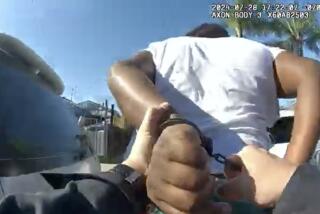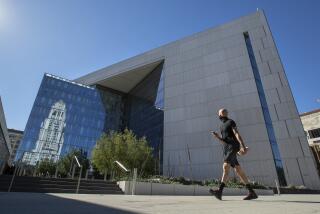LAPD hopes new video policy can turn dangerous clashes into teachable moments

The Los Angeles Police Department has released a video showing a May 12 officer-involved shooting in South L.A. The department’s stylized approach to creating such videos has drawn criticism.
The video highlighting a deadly clash between Los Angeles police and a suspected prowler doesn’t start with a shouted command, a grainy image or other hallmarks that have defined body-worn camera recordings of controversial uses of force in recent years.
Instead, the LAPD’s chief spokesman explains what is about to be shown and why it may be troubling, even warning that “viewer discretion is advised.” The rest of the 17-minute video cuts between a 911 call, clips from the two-hour standoff that took place in South L.A. last month and narration by an LAPD commander, who calmly explains the situation and the types of weapons used by police during the encounter.
As high-profile officer-involved shootings continue to stoke a national debate over the way police use force against those they are sworn to protect, several law enforcement agencies across the country have opted to release recordings of violent interactions to the public, in the hopes of rebuilding trust.
But while other cities have chosen to release hours of raw images and recordings, the LAPD unveiled something similar to a documentary when it began complying last week with a new policy that requires disclosure of video recorded during “critical incidents.”
In releasing slick, high-quality productions rather than raw video, the LAPD has said it is hoping not only to provide residents with a firsthand look at the kinds of deadly incidents that have become a source of regular controversy, but also to use the videos to teach residents more about the department and policing as a whole.
“I don’t believe, the way the others have done it, that you learn anything about policing. These releases are to put out facts, one way or the other, but they are also to show the context of these one one-hundredth of a second decisions,” said Police Commission President Steve Soboroff. “It’s a very, very difficult situation and task.”
The LAPD’s stylized approach to video release has drawn some criticism. The American Civil Liberties Union last week questioned the department’s decision to release only portions of an encounter between officers from Newton Division and 25-year-old Jose Chavez, who died in police custody after being struck with a Taser and rounds from a beanbag shotgun on May 6. A cause of death has not been determined.
Some law enforcement experts said that by putting a “Hollywood” spin on the videos, the LAPD might create the perception that it has slanted the videos in their officers’ favor.
“Once you write the narrative, you’re not just putting out the video, you’re sort of fashioning or directing the conversation,” said Eugene O’Donnell, a former New York City police officer and professor of criminology at the John Jay School of Criminal Justice.
In other large jurisdictions like Chicago and Las Vegas, officials began releasing body-worn camera videos as well as third-party recordings captured by surveillance cameras or cellphones years ago. A repository of the raw recordings can be found on YouTube and Vimeo. Those agencies will sometimes hold press conferences to explain the context of the footage, but LAPD officials said they wanted to embed such explanations in the recordings themselves.
“Educating the public about this so they understand the real context of these serious uses of force is really important to us: the narration, adding the B-roll of ‘this is what a camera is, this is what a Metro officer does,’” said Arif Alikhan, the LAPD’s civilian director of constitutional policing.
Under the new policy, the LAPD must release all recordings in its possession related to officer-involved shootings, incidents where a person is hospitalized after force is used or incidents where a person died while in LAPD custody. The recordings must be released within 45 days, with few exceptions, and officials estimate between 40 and 60 videos could be made public annually.
Decisions on what portions to release will normally be made by investigators with the Force Investigation Division and the Inspector General’s Office, which answers to the civilian Police Commission rather than the department’s brass.
In the Chavez case, officials thought it was more important to offer the public what they believed to be a precise narrative of the incident rather than issue the more than 50 hours of often repetitive footage collected during the two-hour standoff.
“What we try to do is mirror as closely as possible what’s going to be used for the adjudication, within a reasonable time frame,” said Cmdr. Alan Hamilton, who heads the Force Investigation Division and whose narration is heard in the videos. “Now, obviously, we could make a two-hour movie, but it’s not gonna be watched.”
Hamilton also cautioned that the clash with Chavez was longer than most critical use-of-force incidents, which usually last only minutes.
The department released the second video under the new policy Tuesday, which included body camera recordings and footage from a nearby surveillance camera of an officer shooting at a man suspected of carrying a firearm in South L.A. on May 12.
Hamilton said the officers approached a man they suspected of being armed, who then fled on foot. In the surveillance footage, the LAPD has circled the right hand of the man carrying what they believe to be a gun as he flees.
An officer then sprints down the street after the man, cursing at him repeatedly and demanding he stop. After several seconds, the officer fires at the suspect while he is running away, but does not hit him. The man then surrenders.
Police said the suspect, 20-year-old Kevin Palencia, discarded the gun, which was not recovered.
The roughly eight-minute video retains the educational component touted by department officials, as Hamilton in introductory remarks explains the workings of the LAPD’s Metro Division — a specialized roaming crime-suppression unit.
Other departments in California have opted to make a wider array of video available to the public. After the shooting death of Stephon Clark drew national attention and days of large protests in Sacramento, police opted to make more than 50 recordings public — including dozens of recordings from body-worn and dashboard cameras, as well as a 911 call and footage taken by a sheriff’s department helicopter.
Sacramento City Councilman Larry Carr, a proponent of the video policy enacted there in late 2016, said officials chose to release all available recordings in order to ensure the public received the most direct information about serious use-of-force cases.
“We didn’t consider producing a video. We considered getting the information out to the public as quickly as possible, so that the public would be assured that we are being open and transparent and honest,” he said. “It was just get the video out, let people see it, and it is what it is.”
Carr acknowledged the videos have sometimes further inflamed aggrieved citizens.
“If we do something wrong, we will admit it and try to fix it, but we’re not gonna hide anything from people, even though it might incite some people to protest action,” Carr said. “It’s still better for us as a city.”
Alikhan said the LAPD can still achieve transparency while providing a condensed but accurate account when officers employ deadly force.
“Other jurisdictions, they’ve adopted policies where they have to do it in a blanket way, but the problem with those things is you get a lot of raw footage,” he said. “It’s sort of like watching a football game with no narration, just one camera … in an environment that you don’t know.”
Follow @JamesQueallyLAT for crime and police news in California.
More to Read
Sign up for Essential California
The most important California stories and recommendations in your inbox every morning.
You may occasionally receive promotional content from the Los Angeles Times.











